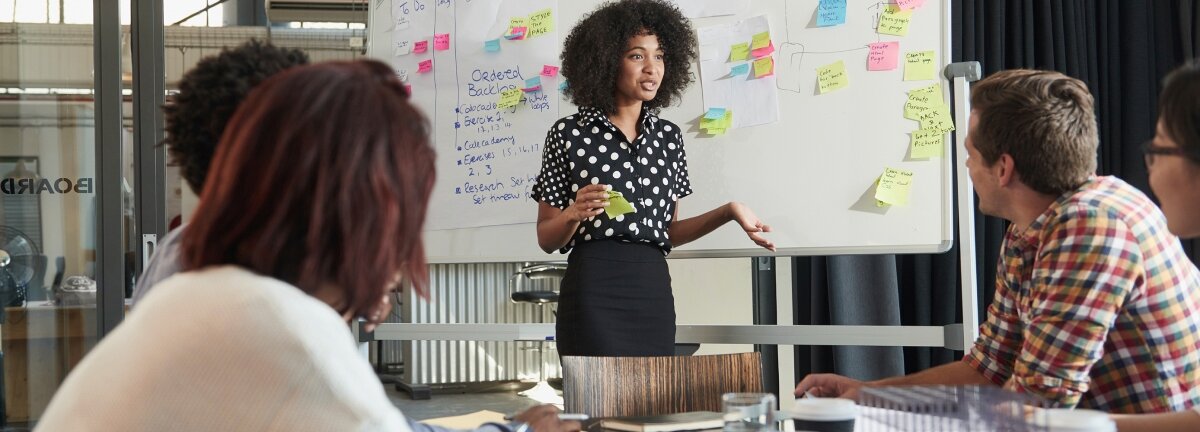Innovating through design thinking

Dawn Baker is Head of Innovation at NCFE, an awarding organisation responsible for the design, development and certification of vocational qualifications. Dawn talked to us about attending the Design Council's design thinking workshops and how it helped them to improve customer experience and bring financial benefits to the business as a whole.
At NCFE, innovation is a key priority. We strive to improve our business processes to achieve cost efficiency, investment in diversification to give us growth, and service and product improvements to increase engagement.
We know that change starts with ideas and these can come from colleagues, customers or partners, so we take a collaborative approach to innovation. This is why we were keen to access design support from Design Council, where we encouraged both external and internal participants to challenge their normal thinking and problem solve through a range of different techniques.
We know that change starts with ideas and these can come from colleagues, customers or partners, so we take a collaborative approach to innovation.
We’ve been impressed with the results from the programme, as it’s shown how innovation is becoming more embedded in our organisation - processes changed, investment opportunities have been pursued to board level, and there is growing engagement, internally and externally. We have also identified a strong pipeline of ideas that could potentially bring us great returns.
Design Coaching
We had our first two-day workshop with Design Associate Nick Devitt in July 2015. We invited colleagues, customers and external contractors with a view to looking at our end-to-end quality assurance process.
At NCFE we provide a great service to our customers – which include colleges, schools, employers and training providers – with our moderators, but we were aware that this could be leaner and slicker.
As part of the workshop, we looked at customer experience. We all went to different local shops – such as chemists, post offices and betting shops – with some of us being ‘participators’ and others being ‘observers’. We picked up on where there were dips in the customer experience, and looked at where you could self-serve versus needing to seek advice.
Since undertaking this exercise at the workshop, we’ve been working our way through the ideas and have already had some successes.
Back at base, we drew pictures of the experience and the ‘pain points’, completed a mood monitor, worked out where we’d get different gains and undertook a cost-benefit analysis. Next, we analysed our own customer journey within this context and discussed how we could improve it. We generated 35 ideas and then ranked the ideas in terms of the biggest wins for customers and opportunities for us.
Since undertaking this exercise at the workshop, we’ve been working our way through the ideas and have already had some successes. One example is the way we manage our Direct Claim Status (DCS) process. Having DCS means customers can draw down funding more quickly. Previously, if a college or training provider wanted to switch to NCFE from another awarding organisation, we’d ask them for DCS evidence which was a slow process and could take up to three months. Now, we can facilitate an immediate switch of business by asking the customer to sign a declaration and allowing them to provide evidence later on.
The follow-up sessions
We found the first design thinking workshop so valuable that we booked in a similar follow-up session in which we talked about allocations.
This was accounting for 19 per cent of all calls coming in to our Centre Support team, so was something we wanted to review to see what changes could be made. We came up with four ways to improve the service we offer –we’re planning to make these changes for September 2016. We’re confident that this will benefit us and our customers and will result in ongoing savings.
What’s clear from our work to date with Design Council is that collaborating with customers, using design thinking techniques to tackle challenges... are key to our future success in innovation.
The content of the programme and Nick’s flexibility in terms of the design thinking techniques used, plus the input of customers, has meant they’ve been extremely valuable for us as a business.
We’ll continue to progress some of our existing concepts, including interesting ideas that could give us operational excellence, market extension and market diversification. What’s clear from our work to date with Design Council is that collaborating with customers, using design thinking techniques to tackle challenges, and not just mapping out but actually putting ourselves through the customer experience and visualising this are all key to our future success in innovation.
As a consequence of what we’ve learned, I’m now regularly on the road visiting customers to understand their pain points and to see how we can match these with the ideas we’ve come up with. This is a big change in the way we work and we’re seeing some great results already.
Subscribe to our newsletter
Want to keep up with the latest from the Design Council?
